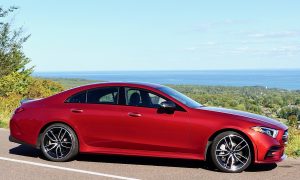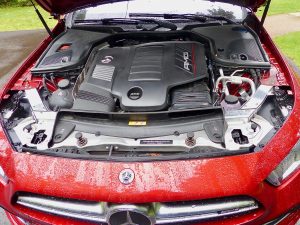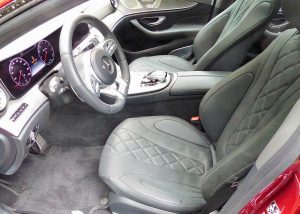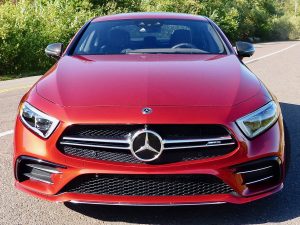Letters, numbers make AMG CLS53 Coupe stand out
By John Gilbert
There are Mercedes fans who like the E-Class best of all the German sedans, and there are luxury car buyers who insist the S-Class is best. The masses might prefer the obtainability of the more compact C-Class. You don’t have to be an auto researcher to figure out what Mercedes is doing, but it wouldn’t hurt.
All I know is that I recently had a Mercedes CLS for a week — but it wasn’t “just” a CLS. It was an “AMG CLS53 Coupe,” which isn’t a true coupe at all, and it adds the sizzle of that AMG prefix. It came in Cardinal Red Metallic paint, and the AMG guys have built a special new engine for it — a 3.0-liter in-line 6-cylinder engine with hybrid electrical energy boost to 429 horsepower and 384 foot-pounds of torque.
A basic C-Class sedan starts at $41,500, with a 2.0-liter 4-cylinder that is quick and can get you over 30 miles per gallon all the time. Add CLS to the mix and you’re up to a $70,000 base price. And when you put AMG into the picture along with the CLS, and the impact of hybrid complementary power and 4Motion all-wheel drive, the sticker price on my test car was a cool $106,980.
The car has the look of some hot-rod styling upgrades, German style, and it goes like the proverbial bullet, on upgraded tires, wheels, suspension, chassis and drivetrain components, making it rise toward actually being worth such a lofty price. People seem to have money, and after they buy a fancy house with way-more bedrooms and bathrooms than they need, buying a couple of cars makes some sort of sense. And buying a car like the high-end AMG CLS53 Coupe seems somewhat logical.
Back for some remedial Mercedes research, here’s a brief overview:
The most impressive thing about the ongoing path of Mercedes Benz automobiles is that every time the company brings out a new model of any of its vehicles, they invariably stand up as the best of the batch. The C-Class was the base size and price, the E-Class midsize, ad the S-Class large and luxurious.

Giving the roofline a symmetric slope turns a 4-door sedan into something worthy of the “Coupe” nickname.
Then at one model change, the designers gave the C-Class a neat slope, making a continuous roofline that looked almost coupe-like. They called it, in fact, a “Four-door Coupe.” The have added to the stable, with the new A-Class and CLA-Class, and the sportier versions, designated with SL or SLC. Then, of course, Mercedes leaped into the SUV battle and expanded to a whole fleet of different sized SUVs.
My favorite remained the C-Class, because it was sleek, a bit smaller, roomy enough, quick enough, and had that great and sporty roofline. It branched off to add the CLS-Class, which is a sportier version of the C-Class, and while the basis C-Class was changed a year ago, 2019 is the year of major modifications to the CLS-Class.
So many models, so many variations, so many engines. And then there’s AMG. Back in 1967, a couple of Mercedes mechanics who had tried to push for more high-performance models broke off and started up their own engine shop. Hans-Werner Aufrect, born in Grobaspach, Germany, was joined bay Erhard Melcher, and the two started building engines on their own. They picked the acronym AMG to stand for Aufrect, Melcher, and Aufrect’s birthplace.
Their favorite cars to upgrade were, not surprisingly, Mercedes models. They started to hang on with the factory production of cars, and were soon brought in as a very close subsidiary. It got to the point where each line that added an AMG model would get the same upgrade, starting with an engine built to lofty standards by one engineer. Then they strengthened the frame, and the suspension parts, and the transmission, as well as the interior.
In the revised CLS, there are two engines available — both of them 3.0-liter in-line 6es, one with a turbo and electric hybrid boost to 362 horsepower and 369 foot-pounds of torque, for the $70,000 range, and the upgrade to more power and more boost to 429/384.
When you drive the garden-variety Mercedes, you can’t imagine anything pushing out the boundaries more than that. Then you climb into the AMG version, and you understand immediately why people spend great quantities of money to get those three little letters.
The 9-speed AMG automatic Speedshift TCT is smoothly precise, and if you choose to not use the steering wheel paddles with their fun quotient of 10, on a scale of 1-10, it seems to shift up or down even harder and with the same precision.
Other AMG items are the Dynamic Select mode switch, Performance 4Matic all-wheel drive, Sport Suspension with air body-control, and the sport steering wheel with its flat bottom, to clear your thighs easily in hard cornering. Also, more AMG items include the twin-spoke black wheels, the AMG Performance Exhaust, the AMG Track-Pace Application, AMG exterior carbon-fiber mirror covers and rear spoiler.
Inside, the black and titanium grey pearl Nappa leather seats and trim set off the natural grain grey ash wood on the dashboard and door panels. The active bucket seats are active because they will swing into motion to give you an energizing massage at various levels, and locations in your backrest. When you’re sitting in the bucket front seat and you drive hard into a curve or corner, the outside seat bolster inflates and firms up to prevent you from — what? — falling out, maybe.
The dashboard and headliner and door panels are also in that “Titanium Grey Pearl” Nappa leather.
A Burmester 3D Surround Sound audio system is complemented by increased cabin insulation, acoustic and heat-absorbing membrane on the windshield and side windows for better sound insulation. Air-balance cabin air purification and fragrance systems take care of air filtration on the inside.
All of this is pretty lofty stuff, and the more universally common elements are also present, things like route-based speed adaptation, which we think of as cruise control, rear-end collision protection, active blind-spot assist, lane keeping assist, steering assist, brake assist with cross traffic function, active lane change assist, and Distronics, the first-out Mercedes safety element that can stop your AMG CLS53 Coupe without hitting an object in the road ahead if you somehow don’t seem to see it, while the car’s radar and camera system do.
Keyless entry and ignition, Apple CarPlay and Android Auto are on board, and the navigation system displays its maps on a 12.3-inch wide-screen screen. Things like the heads-up display and satellite radio are great features, but almost seem inconsequential next to the laundry list of features I’ve tried to cover, here.
After evaluating all of the parts of the Mercedes AMBG CLS53 Coupe, you place it in a different perspective. Yes it goes like a race car, handles better than some race cars, will see and help you see obstacles and avoid them, and it’s extremely comfortable and fulfilling to drive every mile on your way. It performs like a performance car, coddles you like a luxury car, sound like a race car with its mellow but adjustable exhaust that goes from rumble to roar, and it can handle a family of four with ease, grace, luxury and sportiness.
Does that make it worth $107,000? Maybe. But obviously, it makes it worth something quite a way over what you might expect to pay for a 4-door sedan that gets you 27 miles per gallon — this car’s easily reached EPA highway estimate.
You can spend a few bucks over $100,000 to get a luxury car, or to get a high-performance car, or a stunning prestige looker. But to get all of them in one vehicle, the AMG CLS53 will put its pedigree up against any competitor.






 John Gilbert is a lifetime Minnesotan and career journalist, specializing in cars and sports during and since spending 30 years at the Minneapolis Tribune, now the Star Tribune. More recently, he has continued translating the high-tech world of autos and sharing his passionate insights as a freelance writer/photographer/broadcaster. A member of the prestigious North American Car and Truck of the Year jury since 1993. John can be heard Monday-Friday from 9-11am on 610 KDAL(www.kdal610.com) on the "John Gilbert Show," and writes a column in the Duluth Reader.
John Gilbert is a lifetime Minnesotan and career journalist, specializing in cars and sports during and since spending 30 years at the Minneapolis Tribune, now the Star Tribune. More recently, he has continued translating the high-tech world of autos and sharing his passionate insights as a freelance writer/photographer/broadcaster. A member of the prestigious North American Car and Truck of the Year jury since 1993. John can be heard Monday-Friday from 9-11am on 610 KDAL(www.kdal610.com) on the "John Gilbert Show," and writes a column in the Duluth Reader.